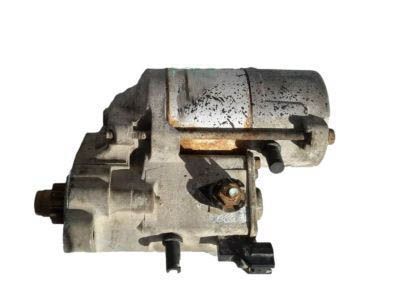| 1996-2002 Toyota 4Runner | LULI, SR5B, SR5V|4 Cyl 2.7L, 6 Cyl 3.4L | 3RZFE, 5VZFE; RZN180L-GKMSKA, RZN180L-GKPSKA, RZN185L-GKMSKA, RZN185L-GKPSKA, VZN180L-GKPGKA, VZN180L-GKPSKA, VZN180L-GKPZKA, VZN185L-GKMGKA, VZN185L-GKPGKA, VZN185L-GKPSKA, VZN185L-GKPZKA |
| 1994-1998 Toyota T100 | DLX, SR5, STD|4 Cyl 2.7L, 6 Cyl 3.0L, 6 Cyl 3.4L | 3RZFE, 3VZE, 5VZFE; RCK10L-TRMRKA, RCK10L-TRSRKA, VCK10L-THMREA, VCK10L-THSREA, VCK10L-TRMREA, VCK10L-TRMREK, VCK10L-TRMSEA, VCK10L-TRMSEK, VCK10L-TRSREA, VCK10L-TRSREK, VCK10L-TRSSEA, VCK10L-TRSSEK, VCK11L-CRMDKA, VCK11L-CRMDKK, VCK11L-CRMSKA, VCK11L-CRSDKA, VCK11L-CRSDKK, VCK11L-CRSSKA, VCK11L-THMDKA, VCK11L-THSDKA, VCK11L-TRMDKA, VCK11L-TRMDKK, VCK11L-TRMRKA, VCK11L-TRMSKA, VCK11L-TRSDKA, VCK11L-TRSDKK, VCK11L-TRSSKA, VCK20L-TRMREA, VCK20L-TRMREK, VCK20L-TRMSEA, VCK20L-TRMSEK, VCK20L-TRSREA, VCK20L-TRSREK, VCK20L-TRSSEA, VCK20L-TRSSEK, VCK21L-CRMDKA, VCK21L-CRMDKK, VCK21L-CRMSKA, VCK21L-CRMSKK, VCK21L-CRSDKA, VCK21L-CRSDKK, VCK21L-CRSSKA, VCK21L-CRSSKK, VCK21L-TRMDKA, VCK21L-TRMDKK, VCK21L-TRMSKA, VCK21L-TRMSKK, VCK21L-TRSDKA, VCK21L-TRSDKK, VCK21L-TRSSKA, VCK21L-TRSSKK |
| 1995-2004 Toyota Tacoma | DLX, SR5|4 Cyl 2.4L, 4 Cyl 2.7L, 6 Cyl 3.4L | 2RZFE, 3RZFE, 5VZFE; RZN140L-TRMDKAB, RZN140L-TRPDKAB, RZN140L-TRSDKAB, RZN150L-CRMDKAB, RZN150L-CRPDKAB, RZN150L-CRSDKAB, RZN161L-TRMDKAB, RZN161L-TRPDKAB, RZN171L-CRMDKAB, RZN171L-CRPDKAB, RZN191L-TRPDKAB, RZN196L-CRPDKAB, RZN196L-PRPDKAB, VZN150L-CRMDKAB, VZN150L-CRSDKAB, VZN160L-TRMDKAB, VZN170L-CRMDKAB, VZN170L-CRMGKAB, VZN170L-CRPDKAB, VZN170L-CRPGKAB, VZN170L-PRPDKAB, VZN195L-CRPDKAB, VZN195L-PRPDKAB |
| 2000-2005 Toyota Tundra | DLX, Limited, SR5|6 Cyl 3.4L, 6 Cyl 4.0L, 8 Cyl 4.7L | 1GRFE, 2UZFE, 5VZFE; GSK30L-ARBSKA, GSK30L-ARFSKA, GSK30L-TRBDKA, GSK30L-TRBDKK, GSK30L-TRFDKA, UCK30L-ARBLKA, UCK30L-ARBSKA, UCK30L-ARBSKK, UCK30L-ARSLKA, UCK30L-ARSLKK, UCK30L-ARSSKA, UCK30L-ARSSKK, UCK30L-ASBLKA, UCK30L-ASBSKA, UCK30L-ASSLKA, UCK30L-ASSSKA, UCK30L-TRBDKA, UCK31L-PRBLKA, UCK31L-PRBSKA, UCK31L-PRBSKK, UCK31L-PRSLKA, UCK31L-PRSSKA, UCK31L-PRSSKK, UCK40L-ARBLKA, UCK40L-ARBLKK, UCK40L-ARBSKA, UCK40L-ARBSKK, UCK40L-ARSLKA, UCK40L-ARSLKK, UCK40L-ARSSKA, UCK40L-ARSSKK, UCK40L-ASBLKA, UCK40L-ASBSKA, UCK40L-ASSLKA, UCK40L-ASSSKA, UCK40L-TRBDKA, UCK40L-TRBDKK, UCK40L-TRSDKK, UCK40L-TRSSKA, UCK41L-PRBLKA, UCK41L-PRBLKK, UCK41L-PRBSKA, UCK41L-PRBSKK, UCK41L-PRSLKA, UCK41L-PRSLKK, UCK41L-PRSSKA, UCK41L-PRSSKK, VCK30L-ARMSKA, VCK30L-ARSLKA, VCK30L-ARSSKA, VCK30L-ARSSKK, VCK30L-TRMDKA, VCK30L-TRMDKK, VCK30L-TRSDKA, VCK30L-TRSDKK, VCK40L-ARMSKA, VCK40L-ARMSKK, VCK40L-ARSLKA, VCK40L-ARSSKA, VCK40L-ARSSKK, VCK40L-TRMDKK, VCK40L-TRMSKA, VCK40L-TRSDKK, VCK40L-TRSSKA |















